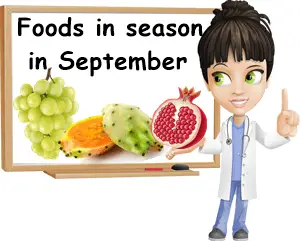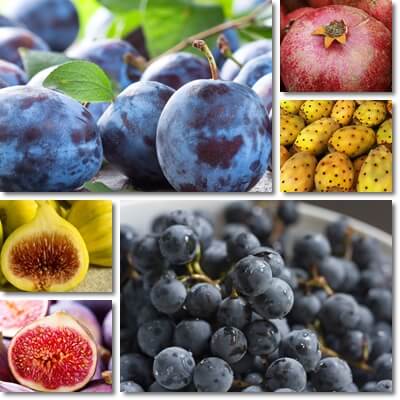September is a foot into summer and a foot into fall. Food-wise, this means there are a lot of options to choose from, one healthier than the other.
There are so many foods in season in September. Some are just coming into season, such as cranberries, sweet potatoes or walnuts, while others are approaching the end of their season, such as prickly pears, watermelon, marrow, peppers and tomatoes.
Sure, most of these September fruits and vegetables can be grown in greenhouses or relocated in gentler, warmer tropical climates, ensuring a steady supply even out of season. There are definitely workarounds. However, you can often tell when fruits and vegetables are grown just right, in season and locally, versus in forced environments. So while you can find most foods at almost any time of year, irrespective of their seasonality, here is a list of fruits and vegetables in season in September and some quick facts about their nutrition and health benefits in case you were hesitant about eating them.

What’s in season in September?
Prickly pear
A cactus fruit with antidiabetic properties and high in red, orange and yellow betalain antioxidants such as betanin and indicaxanthin (also found in red beets and dragon fruit).
Watermelon
September is the last call for seasonal watermelon and you can choose between pink and red, yellow watermelon and orange watermelon and get antioxidants such as red lycopene, yellow xanthophylls or orange carotenes, as well as benefits from citrulline in the white part of watermelon.
Tomatoes
Tomatoes are seasonal summer fruits that extend into autumn, but September is last call for those perfectly ripe and flavorful tomatoes. Choose red tomatoes for a boost in lycopene and benefits for high blood pressure or yellow tomatoes for lots of lutein and zeaxanthin and benefits for eyesight.

Green tomatoes
For temperate regions, green tomatoes are in season in September at the latest, and quite the healthy fruit and vegetable. Pick and pickle your unripe green tomatoes for a savory prebiotic food, or use them for sauces, stews or a chutney or relish. As for their benefits, green tomatoes have scientifically proven anticancer properties.
Find out more about tomatoes as an anticancer food.
Eggplants
Eggplants are an exquisite vegetable in season in September. The skin is a rich source of pigmented antioxidants. Dark purple, pink purple and black eggplants are high in anthocyanin antioxidants with anticancer benefits, but other colors such as yellow eggplants, white eggplants and green eggplants are also sources of important antioxidants.
Rose hips or haws
Rose hips are the fruits of rose plants, both cultivated and wild varieties, and they in season starting August and throughout September and October. Wild rose hips are exceptional sources of vitamin C at an average of 300-400 mg of vitamin C per 100 g. In addition to this, rose hips are high in antioxidants with strong anti-inflammatory benefits and antirheumatic properties. Rose hip tea has proven benefits for high blood pressure and heart failure.
Cranberries
September is very early for cranberries, yet they are in season this early. If you have been fighting frequent UTIs, then it could help to drink cranberry juice. Cranberry juice is reported to help prevent and reduce the rate of urinary tract infection in those predisposed to UTIs.
Fresh figs
Figs are good in September as well as October and one of the most exquisite fruit. If you’re craving sweets, eat a few fresh figs instead of a candy bar. Fresh figs are rich in natural sugars and taste extremely sweet, so they’ll satisfy your sweet tooth in a healthy way.
Pomegranate
Pomegranates are a fruit in season in September and an important source of antioxidants. The red, juicy arils, aka the pomegranate seeds, are high in dietary fiber and help regulate transit and relieve constipation naturally, as well contribute to healthier blood cholesterol levels.
Physalis
From July to September, physalis is in season. Also known as groundcherry, physalis is a good source of vitamin C, B1 and B2, as well as iron and phosphorus. Naturally occurring components in physalis have demonstrated in vitro antibacterial and antiparasitic effects against the parasite-borne illness leishmaniasis.
Grapes
Of all the fruits in season in September (and October), grapes are one of the best. Each grape color is a source of unique antioxidants that actively scavenge free radicals and help combat, reduce and repair damage to cells. Grapes also contain resveratrol, a bioactive organic chemical with benefits for blood pressure and cardiovascular health in general. Red grapes contain proanthocyanidin antioxidants with benefits for urinary tract infections.
Apples
Apples are available year-round these days, but used to be in season in August, September and October. Apples are not the most nutritious fruit, but do hold their value in terms of healthy food. Chilled, slightly tangy apples are the best and sometimes only food you can eat for nausea or diarrhea. They’re also low in calories and a source of antioxidants.
Plums
Dark colored plums ranging from blue-purple to red-purple and red-violet are sources of anthocyanin antioxidants with scientifically proven anticancer properties, including free radical-scavenging, anti-inflammatory, antiproliferative, anti-carcinogenic and apoptotic in vitro and in vivo effects against colon, liver, esophagus, skin, breast and leukemic cancer cell lines.
Pears
Pears are a seasonal summer and autumn fruit, with lots of varieties being in season in September. One of the biggest benefits of pears is they have a low allergenic potential. The fruit further helps relieve constipation thanks to a good dietary fiber content found mostly in the skin, and contains pectin and other forms of fermentable dietary fibers that feed good gut bacteria populations for better gut health.
Hass avocado
Hass avocado is in season from May and all throughout September. An extremely nutritious fruit, avocado is sodium-free and a great source of magnesium and potassium with benefits for high blood pressure. It’s also high in vitamin K for blood coagulation, and vitamins B1, B2, B, B5, B6 and B9 with benefits for energy metabolism, skin, the nervous system and pregnant women.
Sweet and spicy peppers
There are tens of thousands varieties of peppers. In temperate regions, peppers are in season from June and all throughout September. Each color is indicative of a specific class of antioxidants. For example, black peppers are high in anthocyanins, chocolate peppers are sources of carotenoids and pheophytin from chlorophyll, red and orange peppers are sources of carotenes, yellow peppers are sources of xanthophylls, while green and white peppers are sources of chlorophyll.
Carrots
September is a great month for carrots, although the staple veggie can be found year round. Choose your favorite carrot color and get special benefits for health. Orange carrots are high in pro-vitamin A beta-carotene with benefits for eyes, skin and the immune system. Yellow carrots are high in xanthophylls such as lutein with benefits for vision. Black carrots and purple carrots are high in anthocyanin antioxidants with anticancer benefits.
Cantaloupe
Last call for seasonal cantaloupe is September. Cantaloupe is good for you because it is high in pro-vitamin A antioxidants with benefits for eyesight, skin and the immune system, and vitamin C with strong anti-inflammatory and immune system boosting properties, as well as antiaging benefits, boosting collagen production in the skin. Extremely flavorful and a nutritious options, you can even eat cantaloupe if you have diabetes.
Arugula (rocket salad)
Arugula is low-carb and a great September veggie option if you are on the keto-diet, or just looking to eat healthy. In season right now, arugula is an exceptional source of vitamin K for blood coagulation, with over 100% of daily values of the vitamin per 100 g serving, so keep to a low intake if you are on anticoagulants such as warfarin. Arugula also has lots of magnesium and potassium for high blood pressure and iron and vitamins B6 and B9 with benefits for fatigue, weakness and anemia, including in pregnant women, and benefits for the normal development of the baby during pregnancy.
Broccoli
A cool season annual crop, broccoli starts it season in September in the Northern hemisphere. Right now, the green veggie is cheap enough to start stocking it up for the winter. A serving of 100 g of broccoli provides all the vitamin C and vitamin K you need a day (just remember that even light cooking will cause it to lose up to half of its vitamin C). Broccoli has lots of B vitamins and helps combat weakness, tiredness and fatigue, and calcium, magnesium and phosphorus for strong, healthy bones and teeth.
Radishes
Last call for summer radishes is September. If you’re starting to see them at the supermarket or farmer’s market, do not hesitate. Radishes naturally contain organic sulfur compounds with anticancer properties. Eat them raw for their good vitamin C content with benefits for the immune system and a boost in collagen production for more youthful looking skin. Radishes are also good for pregnancy, promoting the normal development of the baby in the womb, fatigue and high blood pressure.
Walnuts
It’s September so it’s walnut season. By now, walnuts are fully grown and either still slightly milky or just ready. The September, and October, culinary nut is extremely nutritious and a great vegetarian and vegan food option. Walnuts are a source of healthy oils, including ALA Omega-3 fatty acids, and make a great brain food. Also high in folate, they are good to eat during pregnancy for the normal development of the brain, spine and spinal cord of the baby in the womb. A source of zinc, walnut are a great immune system support going into the cold season, and high in phosphorus for strong, healthy bones.
Sweet potatoes
Sweet potatoes are harvested in September and early October which means they are in season right now. Whatever is the color you may choose, you can’t go wrong. Yellow and orange sweet potatoes have pro-vitamin A beta-carotene with benefits for the eyes and the immune system. Purple sweet potatoes have anthocyanins with scientifically proven anticancer benefits. Sweet potatoes in general have blood pressure lowering properties, immune system boosting and anti-inflammatory effects and combat anemia related weakness, tiredness and fatigue.
